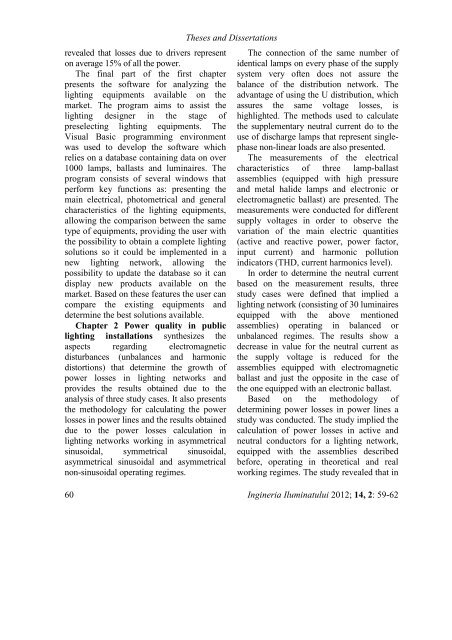Untitled - Journal of Lighting Engineering
Untitled - Journal of Lighting Engineering
Untitled - Journal of Lighting Engineering
You also want an ePaper? Increase the reach of your titles
YUMPU automatically turns print PDFs into web optimized ePapers that Google loves.
evealed that losses due to drivers represent<br />
on average 15% <strong>of</strong> all the power.<br />
The final part <strong>of</strong> the first chapter<br />
presents the s<strong>of</strong>tware for analyzing the<br />
lighting equipments available on the<br />
market. The program aims to assist the<br />
lighting designer in the stage <strong>of</strong><br />
preselecting lighting equipments. The<br />
Visual Basic programming environment<br />
was used to develop the s<strong>of</strong>tware which<br />
relies on a database containing data on over<br />
1000 lamps, ballasts and luminaires. The<br />
program consists <strong>of</strong> several windows that<br />
perform key functions as: presenting the<br />
main electrical, photometrical and general<br />
characteristics <strong>of</strong> the lighting equipments,<br />
allowing the comparison between the same<br />
type <strong>of</strong> equipments, providing the user with<br />
the possibility to obtain a complete lighting<br />
solutions so it could be implemented in a<br />
new lighting network, allowing the<br />
possibility to update the database so it can<br />
display new products available on the<br />
market. Based on these features the user can<br />
compare the existing equipments and<br />
determine the best solutions available.<br />
Chapter 2 Power quality in public<br />
lighting installations synthesizes the<br />
aspects regarding electromagnetic<br />
disturbances (unbalances and harmonic<br />
distortions) that determine the growth <strong>of</strong><br />
power losses in lighting networks and<br />
provides the results obtained due to the<br />
analysis <strong>of</strong> three study cases. It also presents<br />
the methodology for calculating the power<br />
losses in power lines and the results obtained<br />
due to the power losses calculation in<br />
lighting networks working in asymmetrical<br />
sinusoidal, symmetrical sinusoidal,<br />
asymmetrical sinusoidal and asymmetrical<br />
non-sinusoidal operating regimes.<br />
60<br />
Theses and Dissertations<br />
The connection <strong>of</strong> the same number <strong>of</strong><br />
identical lamps on every phase <strong>of</strong> the supply<br />
system very <strong>of</strong>ten does not assure the<br />
balance <strong>of</strong> the distribution network. The<br />
advantage <strong>of</strong> using the U distribution, which<br />
assures the same voltage losses, is<br />
highlighted. The methods used to calculate<br />
the supplementary neutral current do to the<br />
use <strong>of</strong> discharge lamps that represent singlephase<br />
non-linear loads are also presented.<br />
The measurements <strong>of</strong> the electrical<br />
characteristics <strong>of</strong> three lamp-ballast<br />
assemblies (equipped with high pressure<br />
and metal halide lamps and electronic or<br />
electromagnetic ballast) are presented. The<br />
measurements were conducted for different<br />
supply voltages in order to observe the<br />
variation <strong>of</strong> the main electric quantities<br />
(active and reactive power, power factor,<br />
input current) and harmonic pollution<br />
indicators (THD, current harmonics level).<br />
In order to determine the neutral current<br />
based on the measurement results, three<br />
study cases were defined that implied a<br />
lighting network (consisting <strong>of</strong> 30 luminaires<br />
equipped with the above mentioned<br />
assemblies) operating in balanced or<br />
unbalanced regimes. The results show a<br />
decrease in value for the neutral current as<br />
the supply voltage is reduced for the<br />
assemblies equipped with electromagnetic<br />
ballast and just the opposite in the case <strong>of</strong><br />
the one equipped with an electronic ballast.<br />
Based on the methodology <strong>of</strong><br />
determining power losses in power lines a<br />
study was conducted. The study implied the<br />
calculation <strong>of</strong> power losses in active and<br />
neutral conductors for a lighting network,<br />
equipped with the assemblies described<br />
before, operating in theoretical and real<br />
working regimes. The study revealed that in<br />
Ingineria Iluminatului 2012; 14, 2: 59-62
















